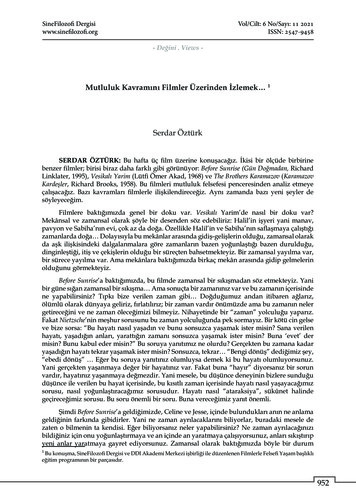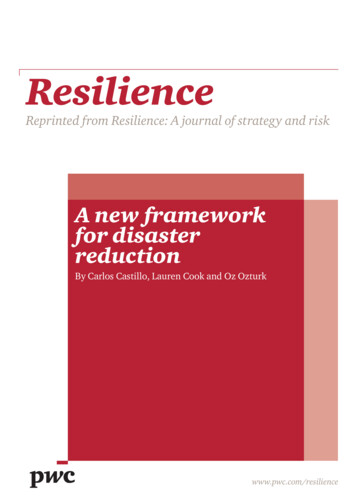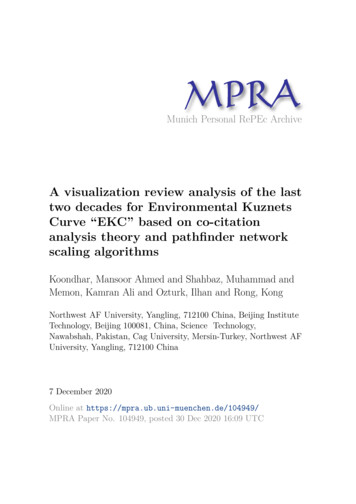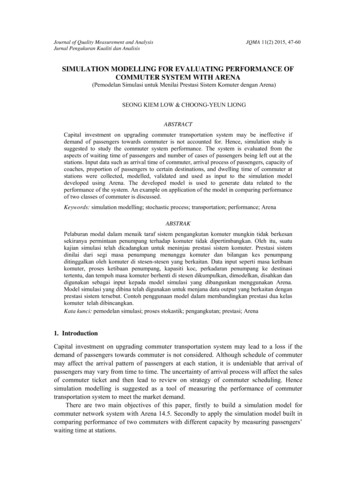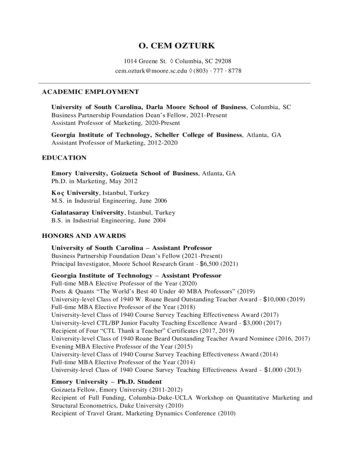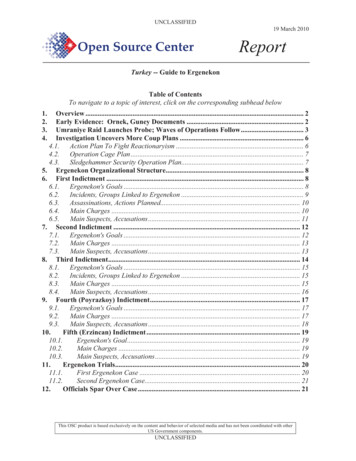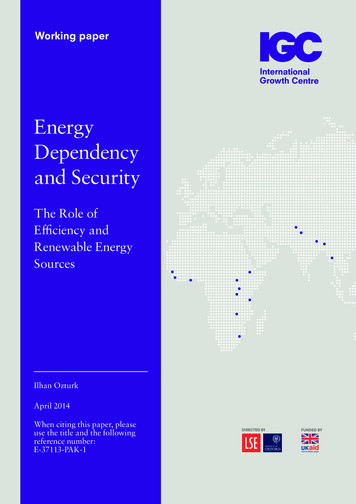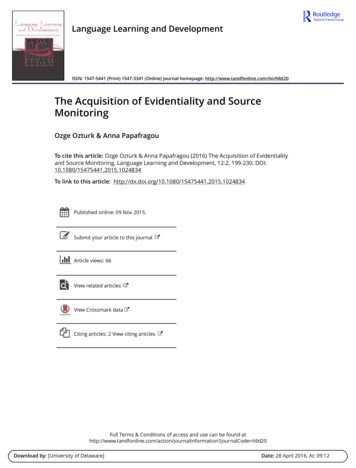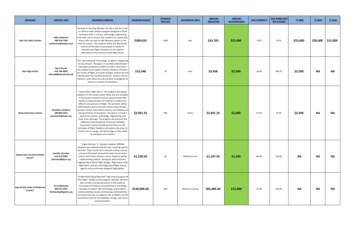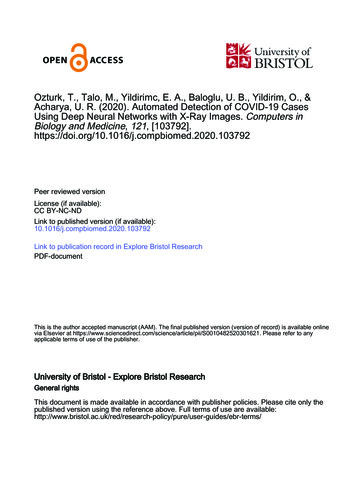
Transcription
Ozturk, T., Talo, M., Yildirimc, E. A., Baloglu, U. B., Yildirim, O., &Acharya, U. R. (2020). Automated Detection of COVID-19 CasesUsing Deep Neural Networks with X-Ray Images. Computers inBiology and Medicine, 121, .103792Peer reviewed versionLicense (if available):CC BY-NC-NDLink to published version (if available):10.1016/j.compbiomed.2020.103792Link to publication record in Explore Bristol ResearchPDF-documentThis is the author accepted manuscript (AAM). The final published version (version of record) is available onlinevia Elsevier at S0010482520301621. Please refer to anyapplicable terms of use of the publisher.University of Bristol - Explore Bristol ResearchGeneral rightsThis document is made available in accordance with publisher policies. Please cite only thepublished version using the reference above. Full terms of use are licy/pure/user-guides/ebr-terms/
Automated Detection of COVID-19 Cases Using Deep Neural Networks withX-ray ImagesTulin Ozturka, Muhammed Talob, Eylul Azra Yildirimc, Ulas Baran Baloglud, Ozal Yildirime*, URajendra Acharyaf,g,hDepartment of Radiology, Medikal Park Hospital, Elazığ, TurkeyDepartment of Software Engineering, Firat University, Elazig, TurkeycComputer Engineer, Ministry of Health, Ankara, TurkeydDepartment of Computer Engineering, University of Bristol, Bristol, UKeDepartment of Computer Engineering, Munzur University, Tunceli, TurkeyfDepartment of Electronics and Computer Engineering, Ngee Ann Polytechnic, SingaporegDepartment of Bioinformatics and Medical Engineering, Asia University, Taichung, TaiwanhInternational Research Organization for Advanced Science and Technology (IROAST), Kumamoto University, Kumamoto, Japan.ab*Corresponding author: oyildirim@munzur.edu.trAbstractThe novel coronavirus 2019 (COVID-2019), which first appeared in Wuhan city of China in December2019, spread rapidly around the world and became a pandemic. It has caused a devastating effect on bothdaily lives, public health, and the global economy. It is critical to detect the positive cases as early aspossible so as to prevent the further spread of this epidemic and to quickly treat affected patients. The needfor auxiliary diagnostic tools has increased as there are no accurate automated toolkits available. Recentfindings obtained using radiology imaging techniques suggest that such images contain salient informationabout the COVID-19 virus. Application of advanced artificial intelligence (AI) techniques coupled withradiological imaging can be helpful for the accurate detection of this disease, and can also be assistive toovercome the problem of a lack of specialized physicians in remote villages. In this study, a new model forautomatic COVID-19 detection using raw chest X-ray images is presented. The proposed model isdeveloped to provide accurate diagnostics for binary classification (COVID vs. No-Findings) and multiclass classification (COVID vs. No-Findings vs. Pneumonia). Our model produced a classification accuracyof 98.08% for binary classes and 87.02% for multi-class cases. The DarkNet model was used in our studyas a classifier for the you only look once (YOLO) real time object detection system. We implemented 17convolutional layers and introduced different filtering on each layer. Our model (available at(https://github.com/muhammedtalo/COVID-19)) can be employed to assist radiologists in validating theirinitial screening, and can also be employed via cloud to immediately screen patients.Keywords: Coronavirus (COVID-19), Deep learning, Chest X-ray images, radiology images.
1. IntroductionCOVID-19 presentation, which began with the reporting of unknown causes of pneumonia inWuhan, Hubei province of China on December 31, 2019, has rapidly become a pandemic [1-3].The disease is named COVID-19 and the virus is termed SARS-CoV-2. This new virus spreadfrom Wuhan to much of China in 30 days [4]. The United States of America [5], where the firstseven cases were reported on January 20, 2020, reached over 300,000 by the 5th of April 2020.Most coronaviruses affect animals, but they can also be transmitted to humans because of theirzoonotic nature. Severe acute respiratory syndrome Coronavirus (SARS-CoV) and the Middle Eastrespiratory syndrome Coronavirus (MERS-CoV) have caused severe respiratory disease and deathin humans [6]. The typical clinical features of COVID-19 include fever, cough, sore throat,headache, fatigue, muscle pain, and shortness of breath [7].The most common test technique currently used for COVID-19 diagnosis is a real-time reversetranscription-polymerase chain reaction (RT-PCR). Chest radiological imaging such as computedtomography (CT) and X-ray have vital roles in early diagnosis and treatment of this disease [8].Due to the low RT-PCR sensitivity of 60%-70%, even if negative results are obtained, symptomscan be detected by examining radiological images of patients [9, 10]. It is stated that CT is asensitive method to detect COVID-19 pneumonia, and can be considered as a screening tool withRT-PRC [11]. CT findings are observed over a long interval after the onset of symptoms, andpatients usually have a normal CT in the first 0-2 days [12]. In a study on lung CT of patients whosurvived COVID-19 pneumonia, the most significant lung disease is observed ten days after theonset of symptoms [13].At the beginning of the pandemic, Chinese clinical centers had insufficient test kits, which are alsoproducing a high rate of false-negative results, so doctors are encouraged to make a diagnosis onlybased on clinical and chest CT results [12, 14]. CT is widely used for COVID-19 detection incountries such as Turkey, where a low number of test kits at onset of the pandemic were available.Researchers state that combining clinical image features with laboratory results may help in earlydetection of COVID-19 [6, 11,15-17]. Radiologic images obtained from COVID-19 cases containuseful information for diagnostics. Some studies have encountered changes in chest X-ray and CTimages before the beginning of COVID-19 symptoms [18]. Significant discoveries have beenrealized by investigators in imaging studies of COVID-19. Kong et al. [6] observed right infrahilar
airspace opacities in a COVID-19 patient. Yoon et al. [19] reported that one in three patientsstudied had a single nodular opacity in the left lower lung region. In contrast, the other two hadfour and five irregular opacities in both lungs. Zhao et al. [16] not only found ground-glassopacities (GGO) or mixed GGO in most of the patients, but they also observed a consolidation,and vascular dilation in the lesion. Li and Xia [17] reported GGO and consolidation, interlobularseptal thickening and air bronchogram sign, with or without vascular expansion, as common CTfeatures of COVID-19 patients. Peripheral focal or multifocal GGO affecting both lungs in 50% 75% of patients is another observation [9]. Similarly, Zu et al. [8] and Chung et al. [6] discoveredthat 33% of chest CTs can have rounded lung opacities. In Fig.1, chest X-ray images taken at days1, 4, 5 and 7 for a 50-year-old COVID-19 patient with pneumonia are given, and explanations ofthese images are also provided [20].Figure 1. Chest X-ray images of a 50-year-old COVID-19 patient with pneumonia over a week [20].Application of machine learning methods for automatic diagnosis in the medical field haverecently gained popularity by becoming an adjunct tool for clinicians [21- 25]. Deep learning,which is a popular research area of artificial intelligence (AI), enables the creation of end-to-endmodels to achieve promised results using input data, without the need for manual feature extraction[26, 27]. Deep learning techniques have been successfully applied in many problems such asarrhythmia detection [28-30], skin cancer classification [31, 32], breast cancer detection [33, 34],brain disease classification [35], pneumonia detection from chest X-ray images [36], fundus imagesegmentation [37], and lung segmentation [38, 39]. The COVID-19 epidemic’s rapid rise hasnecessitated the need for expertise in this field. This has increased interest in developing theautomated detection systems based on AI techniques. It is a challenging task to provide expertclinicians to every hospital due to the limited number of radiologists. Therefore, simple, accurate,and fast AI models may be helpful to overcome this problem and provide timely assistance to
patients. Although radiologists play a key role due to their vast experience in this field, the AItechnologies in radiology can be assistive to obtain accurate diagnosis [40]. Additionally, AIapproaches can be useful in eliminating disadvantages such as insufficient number of availableRT-PCR test kits, test costs, and waiting time of test results.Recently, many radiology images have been widely used for COVD-19 detection. Hemdan et al.[41] used deep learning models to diagnose COVID-19 in X-ray images and proposed a COVIDXNet model comprising seven CNN models. Wang and Wong [42] proposed a deep model forCOVID19 detection (COVID-Net), which obtained 92.4% accuracy in classifying normal, nonCOVID pneumonia, and COVID-19 classes. Ioannis et al. [43] developed the deep learning modelusing 224 confirmed COVID-19 images. Their model achieved 98.75% and 93.48% success ratesfor two and three classes, respectively. Narin et al. [44] achieved a 98% COVID-19 detectionaccuracy using chest X-ray images coupled with the ResNet50 model. Sethy and Behera [45]classified the features obtained from various convolutional neural network (CNN) models withsupport vector machine (SVM) classifier using X-ray images. Their study states that the ResNet50model with SVM classifier provided the best performance. Finally, there are also several recentstudies on COVID-19 detection that employed various deep learning models with CT images [4651].In this study, a deep learning model is proposed for the automatic diagnosis of COVID-19. Theproposed model has an end-to-end architecture without using any feature extraction methods, andit requires raw chest X-ray images to return the diagnosis. This model is trained with 125 chest Xray images, which are not in a regular form and were obtained hastily. Diagnostic tests performedafter 5-13 days are found to be positive in recovered patients [52]. This crucial finding shows usthat recovered patients may continue to spread the virus. Therefore, more accurate methods for thediagnosis is needed. One of the most important disadvantages of chest radiography analyses is aninability to detect the early stages of COVID-19, as they do not have sufficient sensitivity in GGOdetection [8]. However, well-trained deep learning models can focus on points that are notnoticeable to the human eye, and may serve to reverse this perception.
2. Material and Methods2.1 X-ray Image DataSetIn this study, X-ray images obtained from two different sources were used for the diagnosis ofCOVID-19. A COVID-19 X-ray image database was developed by Cohen JP [53] using imagesfrom various open access sources. This database is constantly updated with images shared byresearchers from different regions. At present, there are 127 X-ray images diagnosed with COVID19 in the database. Fig. 2 shows a few COVID-19 cases obtained from the database and thefindings of the experts.Figure 2. A few COVID-19 cases and findings by dataset: (a) Cardio-vasal shadow within the limits [54], (b)Increasing left basilar opacity is visible, arousing concern about pneumonia [5], (c) Progressive infiltrate andconsolidation [55], (d) Small consolidation in right upper lobe and ground-glass opacities in both lower lobes [56], (e)Infection demonstrates right infrahilar airspace opacities [6], and (f) Progression of prominent bilateral perihilarinfiltration and ill-defined patchy opacities at bilateral lungs [57].There are 43 female and 82 male cases in the database that were found to be positive. In thisdataset, a complete metadata is not provided for all patients. The age information of 26 COVID19 positive subjects is given, and the average age of these subjects is approximately 55 years. Also,the ChestX-ray8 database provided by Wang et al. [58] was used for normal and pneumoniaimages. In order to avoid the unbalanced data problem, we used 500 no-findings and 500pneumonia class frontal chest X-ray images randomly from this database.
2.2 The Proposed DarkCovidNet ModelThe advent of deep learning technology has revolutionized artificial intelligence [26, 27]. Theword deep refers to the increase in the size of this network with the number of layers. The structureis named after convolution, a mathematical operator. A typical CNN structure has a convolutionlayer that extracts features from the input with the filters it applies, a pooling layer to reduce thesize for computational performance, and a fully connected layer, which is a neural network. Bycombining one or more such layers, a CNN model is created, and its internal parameters areadjusted to accomplish a particular task, such as classification or object recognition.Instead of initiating a deep model development from scratch, a more rational approach is toconstruct a model using already proven models. Therefore, while designing the deep model usedin this study, the Darknet-19 model [59] is chosen as the starting point. Darknet-19 is the classifiermodel that forms the basis of a real-time object detection system named YOLO (You only lookonce) [59]. This system has the state-of-the-art architecture designed for object detection. TheDarkNet classifier is used on the basis of this successful architecture. We designed theDarkCovidNet architecture (available at https://github.com/muhammedtalo/COVID-19), inspired bythe DarkNet architecture that has proven itself in deep learning, instead of building a model fromscratch. We have used fewer layers and filters as compared to the original DarkNet architectures.We gradually increased the number of filters such as to 8, 16, 32. To better understand this newmodel, it is helpful to understand the basics of the Darknet-19, which consists of 19 convolutionallayers and five pooling layers, using Maxpool. These layers are typical CNN layers with differentfilter numbers, sizes, and stride values. Let the letter C denote a convolutional layer, and M denotea Maxpool layer. As C1 is taken as the input layer, Darknet-19 has a layer layout as -C11-C12-C13-M5-C14-C15-C16-C17-C18-C19For input signal X (image) and kernel K, the two-dimensional convolution operation can be definedas follows.( X * K )(i, j )K (m, n) X (i m, j n)m(1)nwhere * represents the discrete convolution operation. The K matrix slides over the input matrixwith stride parameter. The Leaky rectified linear unit (Leaky ReLu) is used as an activation
function in the DarkNet architecture. The calculation of the leaky ReLu function is given inequation (2).f ( x)0.01x for x 0xfor x 0(2)A schematic presentation for the flow of input data from convolution layer (C) and Max-pooling(M) layer, respectively, is given in Fig. 3.Figure 3. A schematic presentation of convolution and Max-pooling layer operations.This model ends with Avgpool and Softmax layers that produce the outputs. Eventually, a deepmodel with large number of layers is essential for the feature extraction of a real-time objectdetection system. In this study, we encountered a problem in classifying the images with subtledetails. The model performing such classification should have a structure which can capture andlearn small differences rather than being very deep, like ResNets or ResNext [60] models. Anillustration of the proposed model used in this study is shown in Fig. 4.
DNDNDN3 ConvLeakyReluConvBatchNormDNChest X-RayImagesDN: Dark NetConv: 2D ConvolutionMaxP: Max PoolingCOVID-19 ( )No FindingsDetectionCOVID-19 ( )PneumoniaNo FindingsLinearFlattenConv (256,n)ClassificationFigure 4. The architecture of the proposed model (DarkCovidNet).The proposed model has 17 convolution layers. In Fig. 4, each DN (DarkNet) layer has oneconvolutional layer followed by BatchNorm, and LeakyReLU operations, while each 3 Convlayer has the same setup three times in successive form. The batch normalization operation is usedto standardize the inputs, and this operation has other benefits, such as reducing training time andincreasing stability of the model. LeakyReLU is a variation of the ReLU operation used to preventdying neurons. Unlike ReLU or sigmoid activation functions, which have zero value in thenegative part of their derivatives, LeakyReLU has a small epsilon value to overcome the dyingneuron problem. Similar to the Darknet-19 model, the Maxpool method is used in all the poolingoperations. Maxpool downsizes an input by taking the maximum of a region determined by itsfilter. When working with two classes, the proposed model performs the COVID-19 detection task.If three different classes of images are used in the input, the same model performs the classificationtask to determine the labels of the input chest X-ray images as COVID-19, Pneumonia, or NoFindings. Finally, the layer details and layer parameters of the model are given in Table 1. Thedeveloped deep learning model consists of 1,164,434 parameters. We have used the Adamoptimizer for weight updates, cross entropy loss function and selected learning rate as 3e-3.Table 1. The layers and layer parameters of the proposed model (for the binary classification task).Number ofLayer1Layer TypeConv2dOutput Shape[8, 256, 256]Number of TrainableParameters216
Conv2dConv2dConv2dConv2dFlattenLinear[16, 128, 128][32, 64, 64][16, 66, 66][32, 66, 66][64, 33, 33][32, 35, 35][64, 35, 35][128, 17, 17][64, 19, 19][128, 19, 19][256, 9, 9][128, 11, 11][256, 11, 11][128, 13, 13][256, 13, 13][2, 13, 783. Experimental ResultsWe performed experiments to detect and classify COVID-19 using X-ray images in two differentscenarios. First, we have trained the DarkCovidNet deep learning model to classify X-ray imagesinto three categories: COVID-1, No-Findings, Pneumonia. Secondly, the DarkCovidNet model istrained to detect two classes: COVID-19 and No-Findings categories. The performance of theproposed model is evaluated using the 5-fold cross-validation procedure for both the binary andtriple classification problem. Eighty percent of X-ray images are used for training and 20% forvalidation. The experiments are repeated five times as shown in Fig. 5. All of the split k pieces arewrapped in folds to use in the validation stage. We have trained DarkCovidNet for 100 epochs. InFig. 6. the training and validation loss graphs of the multi-class classification and validationaccuracy graphs are shown for the Fold-1.
Chest X-Ray ImagesTrain and Validation SetSplittingValidationTrain on (k-1) 0%20%20%20%Figure 5. Schematic representation of training and validation scheme employed in the 5-fold crossvalidation procedure.1Value (Log Scale)0.80.60.4Train LossValidation LossAcurracy0.2102030405060708090100Number of EpochsFigure 6. Validation, training loss and validation accuracy curves obtained for DarkCovidNet model in fold-1.It can be noted from Fig.6 that there is a significant increase in loss values in the beginning of thetraining, which decrease substantially in the later stage of the training. The main reason for thissharp increase and decrease is attributed to the number of data in the COVID-19 class, which isfar less than the other two (Pneumonia and No-Findings) classes. However, when the deep model
examines all X-ray images over and over again for each epoch during the training, these rapid upsand downs are slowly reduced in the later part of the training.The multi-class classification performance of the DarkCovidNet model has been evaluated foreach fold, and the average classification performance of the model is calculated. The overlappedas well as each separate confusion matrix (CM) are shown in Fig.7. The overlapped CM is createdusing the sum of CMs obtained in all folds. Thus, it is aimed to obtain an idea about the generalperforations of the model. The DarkCovidNet model achieved an average classification accuracyof 87.02% to classify: no findings, COVID-19, and Pneumonia categories. Sensitivity, specificity,precision, F1-score, and accuracy values are shown in Table 2 for the detail analysis of the modelfor the 3-class (f)Figure 7. The overlapped and 5-fold confusion matrix results of the multi-class classification task:(a) overlapped confusion matrix, (b) Fold-1 CM, (c) Fold-2 CM, (d) Fold-3 CM, (e) Fold-4 CM, and (f) Fold-5 CM.
Table 2. Sensitivity, specificity, precision, F1-score, and accuracy values obtained for each fold of the proposedmodel.FoldsPerformance Metrics 88.00Average85.3592.1889.9687.3787.02It can be noted from the overlapped confusion matrix of the multi-class classification task that thedeep learning model classified COVID-19 better than the classes of pneumonia and no findings.The obtained sensitivity, specificity, and F1-score values are 85.35%, 92.18%, and 87.37%,respectively.Secondly, the result of confusion matrixes for the binary classification problem in detectingCOVID-19 positive are shown in Fig. 8. In addition, sensitivity, specificity precision, F1-score,and accuracy results for the binary classification task are given in Table 3.
.0%COVID-19COVID-19Fold-1(f)(e)Figure 8. The overlapped and 5-fold confusion matrix results for the binary classification task: (a) Overlappedconfusion matrix, (b) Fold-1 CM, (c) Fold-2 CM, (d) Fold-3 CM, (e) Fold-4 CM, and (f) Fold-5 CM.Table 3. Sensitivity, specificity, precision, F1-score, and accuracy values for No findings and COVID-19 classes ofthe proposed model.FoldsPerformance Metrics 98.08
It can be noted from Table 3 that the proposed model has achieved an average accuracy of 98.08%in detecting COVID-19 and the obtained average sensitivity, specificity, and F1-score values of95.13%, 95.30%, and 96.51%, respectively.4. Evaluation of the model outputs by the radiologistThis section includes the interpretation of results of the DarkCovidNet model by an expertradiologist. The DarkCovidNet model is designed for the automatic detection of COVID-19 usingX-ray images, without requiring any handcrafted feature extraction techniques. The developedmodel helps to provide a second opinion to expert radiologists in health centers. It maysignificantly reduce the workload of clinicians and assist them to make an accurate diagnosis intheir daily routine work. The proposed model can save time (the diagnostic process is fast); hencespecialists can focus on more critical cases. In this work, we have shared the outputs of the modelwith expert radiologists to confirm model robustness. We shared the top prediction errors of themodel and the actual labels of the X-ray dataset with radiologists. Additionally, we also used theGrad-CAM [61] heat map approach to visually depict decisions made by the deep model. Theheatmap highlights important areas that the model emphasizes on the X-ray. In this way, we haveensured that the outcome of the model is approved by a radiologist. In the clinical setting, anillustration of the model which can provide the second opinion to radiologists is shown in Fig. 9.HeatMapsInput Chest X-ray ImagesEvaluationMachine LearningTrainedDarkCovidNetPredicted/ActualExpert (Radiologist)Figure 9. An illustration of performance evaluation of the model outputs by an expert.
The radiologist comments on the output of DarkCovidNet model are as follows:- The model performed outstandingly in detecting COVID-19 cases for the binary class task.- The DarkCovidNet model is successful in detecting COVID-19 findings.- Clinically, pneumonia images are also later included in the study. Therefore, the model evaluatedpatients with COVID-19 as pneumonia. Since COVID-19 pneumonia is a subset of pneumoniadiseases evaluated by the model, the diagnosis is correct, although the interpretation seems to beincorrect. Therefore, patients identified as COVID-19 are evaluated as pneumonia (see Fig. 10(a)). For this reason, the success rate of the model in the multi-class classification problem isrelatively low as compared to the binary class.-The model is sensitive in detecting pneumonia disease. Although the model can predictpneumonia positively and marked as no findings in the dataset, this patient has a mass (see Fig.10(b)).- The model made the incorrect predictions in poor quality X-ray imagery and in patients withacute respiratory distress syndrome (ARDS), in which the lung image is diffuse and much lungventilation is lost (see Fig.10 (c)).Figure 10. Images evaluated by the radiologist and DarkCovidNet model: (a) Predicted as Pneumonia by model butactual class is COVID-19, (b) Predicted as Pneumonia by model but actual class is No-Findings, (c) Model is correctlydetected as multifocal GGO.-The model is useful to detect COVID-19 with presence of a heat map in normal subjects. Itseffectiveness diminishes in pneumonia and ARDS cases. The heat map showed a greater
concentration area in the X-rays of patients with COVID-19 than the area in which the disease isnot seen (see Fig.11).-The model may be more useful evaluate the efficacy of treatment based on the heatmap. It canalso assist experts in terms of diagnosis, follow-up, treatment, and isolation of patients.Figure 11. X-ray images and the corresponding heat maps: (a) first X-ray image, (b) heat map of (a), (c) second Xray image, and (d) heat map of (c).Fig.12 shows the difference between a few COVID and pneumonia case images. The followingprimary findings are frequently observed in the chest X-rays of COVID-19 patients [15].Ground-glass opacities (GGO) (bilateral, multifocal, subpleural, peripheral, posterior,medial and basal).A crazy paving appearance (GGOs and inter- / intra-lobular septal thickening).Air space consolidation.Bronchovascular thickening (in the lesion).Traction bronchiectasis.Similarly, chest X-ray findings of pneumonia patients are observed as follows [62].
Ground-glass opacities (GGO) central distribution, unilateralReticular opacityVascular thickeningDistribution more along the bronchovascular bundleBronchial wall thickeningIn COVID-19, isolated lobar or segmental consolidation without GGO, multiple tiny pulmonarynodules, tree-in-bud, pneumothorax, cavitation, and hilar lymphadenopathy smoother interlobularseptal thickening with pleural effusion are rare, while these findings can often be seen inpneumonia [9].COVIDFindingsPNEUMONIAAirspace consolidation with airbronchograms in the left lowerzone. Pulmonary aeration issignificantly increased bilaterally.There is marked bronchial wallthickening on the left in theperihilar zone extending to thelung base in keeping withinflammatory lower airwaysdisease. There are non- segmentalpatchy lung opacities in the leftlower lobes.Posterior anterior (PA) l ground-glass with withinamultilobar involvement.COVIDPNEUMONIAFindingsBilateral multifocal ground-glassalveolarconsolidationwithperipheral, subpleural.FindingsFindingsDiffuse combinations of groundglass opacities and consolidationalongandaroundthebronchovascular bundles areaswith interlobular thickening andbronchial wall thickening in theright lower zone. There is alsoincreased interstitial markingswith lower zone predominance.Figure 12. Differences observed by the radiologist between some COVID and pneumonia case images.In the COVID-19 epidemic, radiological imaging plays an important role in addition to thediagnostic tests performed for the early diagnosis, treatment, and isolation sta
Automated Detection of COVID-19 Cases Using Deep Neural Networks with X-ray Images Tulin Ozturka, Muhammed Talob, Eylul Azra Yildirimc, Ulas Baran Baloglud, Ozal Yildirime*, U Rajendra Acharyaf,g,h aDepartment of Radiology, Medikal Park Hospital, Elazığ, Turkey bDepartment of Software Engineering, Firat University, Elazig, Turkey cComputer Engineer, Ministry of Health, Ankara, Turkey

